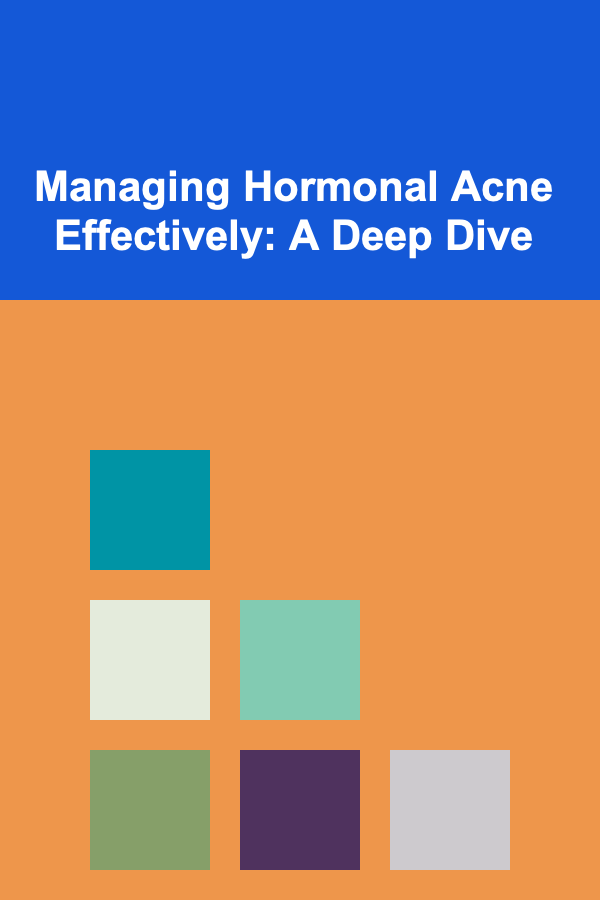
Managing Hormonal Acne Effectively: A Deep Dive
ebook include PDF & Audio bundle (Micro Guide)
$12.99$10.99
Limited Time Offer! Order within the next:

Hormonal acne, a persistent and often frustrating skin condition, is far more than just a superficial annoyance. It's a complex interplay of hormones, inflammation, and skin physiology. While it can affect individuals of any age and gender, it's particularly prevalent among women, often coinciding with hormonal fluctuations during puberty, menstruation, pregnancy, and menopause. Understanding the root causes of hormonal acne is paramount to developing an effective management strategy. This article provides an in-depth exploration of hormonal acne, its causes, and a comprehensive approach to managing and treating it effectively.
Understanding the Hormonal Landscape of Acne
The primary culprits behind hormonal acne are fluctuations in androgen hormones, particularly testosterone and dihydrotestosterone (DHT). While often associated with males, androgens are present in both men and women, albeit in different concentrations. These hormones stimulate the sebaceous glands, leading to increased sebum production. Sebum, an oily substance designed to lubricate and protect the skin, can become problematic when produced in excess. Here's a breakdown of the key hormonal players:
- Androgens (Testosterone & DHT): These hormones bind to receptors in the sebaceous glands, triggering increased sebum production. In women, conditions like Polycystic Ovary Syndrome (PCOS) can lead to elevated androgen levels, contributing significantly to acne development. DHT is a more potent androgen than testosterone and is often responsible for deeper, more cystic acne lesions.
- Estrogen and Progesterone: These hormones, predominantly found in women, play a crucial role in the menstrual cycle. Fluctuations in estrogen and progesterone levels can indirectly affect acne. A drop in estrogen or a relative increase in progesterone (or synthetic progestins found in some birth control pills) can contribute to increased sebum production or altered inflammatory responses.
- Insulin and Insulin-like Growth Factor-1 (IGF-1): These hormones, involved in glucose metabolism, can also influence acne. High insulin levels, often associated with diets high in refined carbohydrates and sugars, can stimulate the production of androgens and IGF-1. IGF-1, in turn, promotes sebum production and keratinocyte proliferation (the growth of skin cells), contributing to clogged pores.
- Cortisol (Stress Hormone): While not directly an androgen, cortisol released during periods of stress can exacerbate acne. Cortisol can increase sebum production and promote inflammation, both of which contribute to acne flare-ups.
The interplay of these hormones creates a complex environment within the skin. Excess sebum, combined with dead skin cells and bacteria (primarily Cutibacterium acnes , formerly known as Propionibacterium acnes), leads to clogged pores. These clogged pores can then become inflamed, resulting in the characteristic lesions of acne, ranging from mild comedones (blackheads and whiteheads) to more severe inflammatory papules, pustules, nodules, and cysts.
Identifying Hormonal Acne: Key Characteristics
Distinguishing hormonal acne from other types of acne is crucial for effective treatment. While the appearance of acne lesions can vary, certain characteristics are suggestive of hormonal involvement:
- Location: Hormonal acne often manifests along the jawline, chin, and lower cheeks. This pattern is distinct from teenage acne, which is more commonly found on the forehead, nose, and upper cheeks.
- Timing: Flare-ups often coincide with hormonal fluctuations, such as those associated with the menstrual cycle (typically worsening in the week leading up to menstruation), pregnancy, postpartum, perimenopause, and menopause.
- Lesion Type: Hormonal acne tends to be inflammatory, often presenting as deep, painful cysts or nodules. These lesions are often slow to heal and can leave behind post-inflammatory hyperpigmentation (PIH).
- Persistence: Hormonal acne tends to be persistent and recurring, often not responding well to standard over-the-counter acne treatments.
- Associated Conditions: The presence of other hormonal imbalances, such as irregular periods, hirsutism (excess hair growth), and weight gain, can further suggest a hormonal component.
It's important to note that these are just general guidelines. A dermatologist can provide a definitive diagnosis and help determine the underlying causes of your acne.
A Multifaceted Approach to Managing Hormonal Acne
Given the complexity of hormonal acne, a multifaceted approach is often necessary for effective management. This approach should encompass skincare, lifestyle modifications, and, in some cases, medical treatments.
1. Optimizing Skincare Routine
A consistent and well-designed skincare routine is the foundation of managing hormonal acne. The goal is to gently cleanse the skin, unclog pores, reduce inflammation, and prevent new breakouts. Here's a recommended routine:
- Gentle Cleansing: Choose a gentle, non-comedogenic cleanser that doesn't strip the skin of its natural oils. Avoid harsh scrubs or abrasive cleansers, as these can irritate the skin and worsen inflammation. Look for cleansers containing ingredients like salicylic acid or benzoyl peroxide (in low concentrations) for mild exfoliation and antibacterial action.
- Topical Retinoids: Retinoids (such as tretinoin, adapalene, and tazarotene) are vitamin A derivatives that are highly effective at treating acne. They work by increasing cell turnover, unclogging pores, and reducing inflammation. Retinoids are available both over-the-counter (e.g., adapalene) and by prescription (e.g., tretinoin). Start with a low concentration and use it sparingly (2-3 times per week) to avoid irritation. Apply at night, as retinoids can make your skin more sensitive to the sun.
- Azelaic Acid: Azelaic acid is a dicarboxylic acid with antibacterial, anti-inflammatory, and comedolytic (pore-clearing) properties. It's particularly effective for treating acne, rosacea, and hyperpigmentation. It's generally well-tolerated and can be used alongside other acne treatments.
- Benzoyl Peroxide: Benzoyl peroxide is a powerful antibacterial agent that kills C. acnes bacteria. It's available in various strengths (2.5% to 10%). Start with a lower concentration to minimize dryness and irritation. It's best used as a spot treatment for active breakouts rather than all over the face. Be cautious, as benzoyl peroxide can bleach fabrics.
- Salicylic Acid: Salicylic acid is a beta-hydroxy acid (BHA) that exfoliates the skin and unclogs pores. It's available in cleansers, toners, and spot treatments. It's effective for treating blackheads and whiteheads.
- Non-Comedogenic Moisturizer: Even if you have oily skin, moisturizing is essential. Choose a lightweight, oil-free, and non-comedogenic moisturizer to keep your skin hydrated and prevent it from overproducing oil.
- Sunscreen: Sunscreen is crucial for protecting your skin from sun damage and preventing post-inflammatory hyperpigmentation (PIH). Choose a broad-spectrum sunscreen with an SPF of 30 or higher and apply it every day, even on cloudy days. Opt for a non-comedogenic formula.
Important Considerations for Skincare:
- Patch Test: Before introducing any new product into your routine, perform a patch test on a small area of skin to check for any allergic reactions or irritation.
- Consistency: Consistency is key to seeing results. Stick to your skincare routine diligently, even when your skin is clear.
- Patience: It can take several weeks or even months to see significant improvement in your acne. Don't get discouraged if you don't see results immediately.
- Avoid Picking and Squeezing: Picking and squeezing acne lesions can worsen inflammation, increase the risk of scarring, and spread bacteria.
- Consult a Dermatologist: If your acne is severe or not responding to over-the-counter treatments, consult a dermatologist for personalized advice and prescription medications.
2. Lifestyle Modifications
Lifestyle factors can play a significant role in hormonal acne. Addressing these factors can complement your skincare routine and improve overall skin health.
- Diet: While the link between diet and acne is still being researched, certain dietary patterns have been associated with increased acne risk. Consider the following:
- Limit Refined Carbohydrates and Sugars: High glycemic index foods, such as white bread, pasta, sugary drinks, and processed foods, can cause rapid spikes in blood sugar levels, leading to increased insulin and IGF-1 production. Choose whole grains, fruits, and vegetables instead.
- Dairy Consumption: Some studies have linked dairy consumption to increased acne risk. Dairy products contain hormones and growth factors that may contribute to inflammation and sebum production. Consider reducing or eliminating dairy from your diet and see if it improves your skin.
- Omega-3 Fatty Acids: Omega-3 fatty acids, found in fatty fish (salmon, mackerel, tuna), flaxseeds, and walnuts, have anti-inflammatory properties and may help reduce acne.
- Antioxidant-Rich Foods: Fruits, vegetables, and green tea are rich in antioxidants, which can help protect the skin from damage and reduce inflammation.
- Stress Management: Stress can trigger the release of cortisol, which can exacerbate acne. Practice stress-reducing techniques such as meditation, yoga, deep breathing exercises, or spending time in nature.
- Sleep: Adequate sleep is essential for overall health and skin health. Aim for 7-8 hours of sleep per night. Sleep deprivation can increase stress hormones and inflammation, contributing to acne.
- Hydration: Drinking plenty of water helps keep your skin hydrated and can improve its overall appearance.
- Exercise: Regular exercise can help regulate hormones and reduce stress. However, be sure to shower immediately after exercising to remove sweat and oil that can clog pores.
3. Medical Treatments for Hormonal Acne
In some cases, skincare and lifestyle modifications may not be enough to effectively manage hormonal acne. Medical treatments, prescribed by a dermatologist, can provide more targeted and potent solutions.
- Hormonal Birth Control Pills: Certain birth control pills containing estrogen and progestin can help regulate hormone levels and reduce acne. They work by decreasing androgen production. However, not all birth control pills are created equal. Some progestins can actually worsen acne. It's important to discuss your options with your doctor to choose a birth control pill that is right for you.
- Spironolactone: Spironolactone is an anti-androgen medication that blocks the effects of androgens on the skin. It's particularly effective for treating hormonal acne in women. It can cause side effects, such as irregular periods and breast tenderness, so it's important to discuss the risks and benefits with your doctor. It is contraindicated during pregnancy.
- Oral Isotretinoin (Accutane): Isotretinoin is a powerful retinoid medication that is used to treat severe acne. It works by reducing sebum production, decreasing inflammation, and preventing clogged pores. It can have significant side effects, including birth defects, so it's essential to be closely monitored by a dermatologist while taking this medication. Women must use two forms of contraception while taking isotretinoin.
- Topical Clascoterone (Winlevi): Clascoterone is a relatively new topical anti-androgen cream that blocks androgen receptors in the skin. It is approved for the treatment of acne vulgaris in individuals 12 years of age and older. It offers a topical alternative to systemic anti-androgen medications.
- Antibiotics: Oral antibiotics (such as tetracycline, doxycycline, and minocycline) can be used to reduce inflammation and kill C. acnes bacteria. However, they are typically used as a short-term solution due to concerns about antibiotic resistance. Topical antibiotics can also be used, but are often combined with benzoyl peroxide to reduce the risk of resistance.
- Chemical Peels: Chemical peels can exfoliate the skin, unclog pores, and reduce inflammation. They are typically performed by a dermatologist or aesthetician.
- Laser and Light Therapies: Laser and light therapies can target C. acnes bacteria, reduce inflammation, and improve skin texture. Blue light therapy, red light therapy, and pulsed dye laser are some common options.
Choosing the Right Medical Treatment:
- Consult a Dermatologist: It's essential to consult a dermatologist for a proper diagnosis and to discuss the most appropriate treatment options for your specific case of hormonal acne.
- Discuss Risks and Benefits: Be sure to discuss the potential risks and benefits of each treatment option with your doctor.
- Consider Your Medical History: Your doctor will take your medical history into account when recommending treatment options.
- Adherence is Key: Adhere to your doctor's instructions carefully and attend all follow-up appointments.
Prevention and Long-Term Management
Even after your acne has cleared, it's important to continue with a maintenance routine to prevent future breakouts. This includes:
- Consistent Skincare: Continue with a gentle skincare routine that includes a retinoid (e.g., adapalene) to prevent clogged pores.
- Healthy Lifestyle: Maintain a healthy diet, manage stress, and get adequate sleep.
- Regular Check-Ups: Schedule regular check-ups with your dermatologist to monitor your skin and address any concerns.
- Be Mindful of Hormonal Changes: Be prepared for potential flare-ups during hormonal fluctuations, such as those associated with menstruation, pregnancy, or menopause.
Conclusion
Managing hormonal acne is a journey that requires patience, persistence, and a comprehensive approach. By understanding the hormonal underpinnings of acne, identifying its unique characteristics, and implementing a combination of skincare, lifestyle modifications, and, when necessary, medical treatments, you can effectively control your acne and achieve clearer, healthier skin. Remember to consult a dermatologist for personalized advice and treatment options. The key is to be proactive, consistent, and patient, and to work with your healthcare provider to develop a long-term management plan that suits your individual needs.

How to Create a Photo Album that Tells a Story
Read More
How to Store Your Holiday Decorations Efficiently
Read More
How To Understand the Philosophy of Emotions
Read More
How to Use Financial Apps to Manage Your Money More Effectively
Read More
How to Design a Home That Reflects Your Personality
Read More
10 Tips for Securing AI Research Funding
Read MoreOther Products

How to Create a Photo Album that Tells a Story
Read More
How to Store Your Holiday Decorations Efficiently
Read More
How To Understand the Philosophy of Emotions
Read More
How to Use Financial Apps to Manage Your Money More Effectively
Read More
How to Design a Home That Reflects Your Personality
Read More